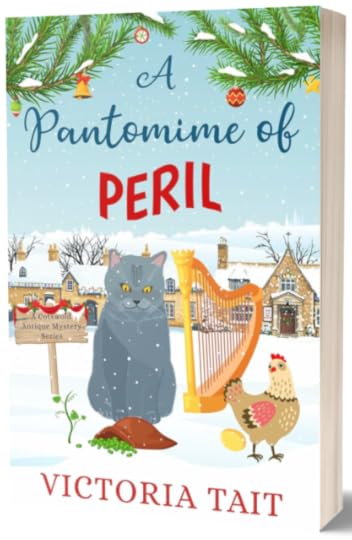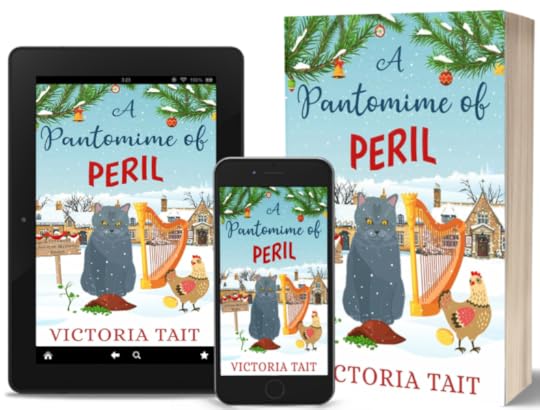A Pantomine of Peril
Zach Forest from A Pantomime of Peril, a Cotswold Antique mystery, is visiting Ascroft, eh? today to share his American view of British pantomime.
Welcome, Zach. I’ll turn the floor over to you –

When I first moved to the Cotswolds, I thought I knew something about theatre. I’d performed in a few college productions back in the US and attended several Broadway shows on visits to New York. So when Dotty suggested we visit the pantomime in Cheltenham last Christmas, I imagined an amateur version of A Christmas Carol or perhaps The Nutcracker.
It turned out to be nothing like that at all.
The show was Mother Goose, and nothing could have prepared me for it. After the fairy godmother introduced the story, a man in a large wig and a polka-dot dress began cracking jokes. Then a goose, played by someone in a feathered costume, waddled across the stage. When the villain appeared, dressed in black, the audience booed loudly, and he laughed as if
That was my introduction to pantomime, or panto as everyone here in the UK calls it. Since then, I have come to realise it is a uniquely British tradition. It is part musical, part comedy, and part moral tale, with its origins in ancient Greece, where the word pantomime meant “imitator of everything.” For many people, from young children to those in their eighties, the annual trip to their local pantomime is one of the highlights of the festive season.
If, like me, you didn’t grow up with pantomimes, here’s how they work. A theatre company or local group performs a well-known story, usually a fairy tale such as Cinderella, Aladdin, or Jack and the Beanstalk. There is always a villain, who must be booed, and a hero, who is often a young woman playing the part of a man.
There is also a dame, traditionally played by a man in an outlandish costume, who tells terrible jokes and sometimes ad-libs when he forgets his lines or starts laughing at himself or his fellow actors. The show includes songs, dances, and a few jokes that go over the children’s heads but make the adults laugh and choke on their mince pies.
Audience participation is part of the fun. If someone creeps up behind a character, the audience calls out, “He’s behind you!” and when the villain insists something is not true, everyone replies, “Oh yes it is!” There is often a sing-along, sometimes with a competition between the boys and the girls or the adults and the children. Sweets are occasionally thrown into the audience, and a few children are even invited up onto the stage.
When I heard that Dr Peter had written a script for Coln Akeman’s own production of Jack and the Beanstalk, I persuaded Dotty to come with me to the auditions. Performing on stage is not really her thing, but I enjoyed myself, especially when reading the giant’s famous lines, “Fee fi fo fum, I smell the blood of an Englishman.” I was not cast as the giant but as his steward, Lord Grubwort. It is a deliberately pompous title, and I had great fun playing the real villain of the pantomime, who lures the princess to the giant’s castle and causes all sorts of trouble.

Being part of the cast also gave me a new respect for the stories themselves. Jack and the Beanstalk has been told for centuries, but it still carries a strong moral thread. Jack, the poor boy who trades his cow for a handful of beans, teaches us about risk and reward. His courage brings him riches, but the tale also warns about greed and knowing when to stop climbing. Perhaps there were others in the cast who might have taken heed of such a lesson, especially those who believed that money and a show of grandeur could buy admiration.
In Coln Akeman, the community side of pantomime is the most important part. Dr Peter suggested putting on the performance to bring some winter cheer to local residents, especially those who are older or less mobile and do not get out much during the festive period.
All the actors were local people, as were those helping with costumes and props. The Waterwheel Café and the Axeman pub provided refreshments, and rehearsals were held in the village hall.
What I have come to appreciate about pantomime is that it brings people together in a simple and cheerful way. It offers a chance for everyone to take part, whether on stage, behind the scenes, or in the audience. It does not aim for perfection, but for enjoyment and connection.
For me, it has also been an introduction to one of Britain’s most enduring winter traditions. It combines humour, music, and community spirit in a way that feels both familiar and entirely new. And, as I have discovered, even the most light-hearted story can sometimes hide a mystery.
Thank you for sharing this with us, Zach, and good luck to you and your author, Victoria Tait, with A Pantomime of Peril, the latest book in the Cotswold Antique mystery series.
Readers can learn more about Zach and his author, Victoria Tait by visiting the author’s website and her Instagram, Pinterest, BookBub and Goodreads pages.
The book is available online at the following retailers:

About Victoria Tait: Victoria was born and raised in Yorkshire, England, where she developed a lifelong love of tea and British traditions. Inspired by the works of Agatha Christie, Dorothy L. Sayers, and Murder, She Wrote, she writes cozy mysteries infused with her signature British charm.
Her determined and hard-working female sleuths are joined by colourful but realistic teams of helpers, and her settings are vivid and evocative. With intrigue, surprises, and gentle humour, Victoria’s page-turning stories are the perfect blend of mystery and charm, best enjoyed with a cup of tea and a slice of cake.



